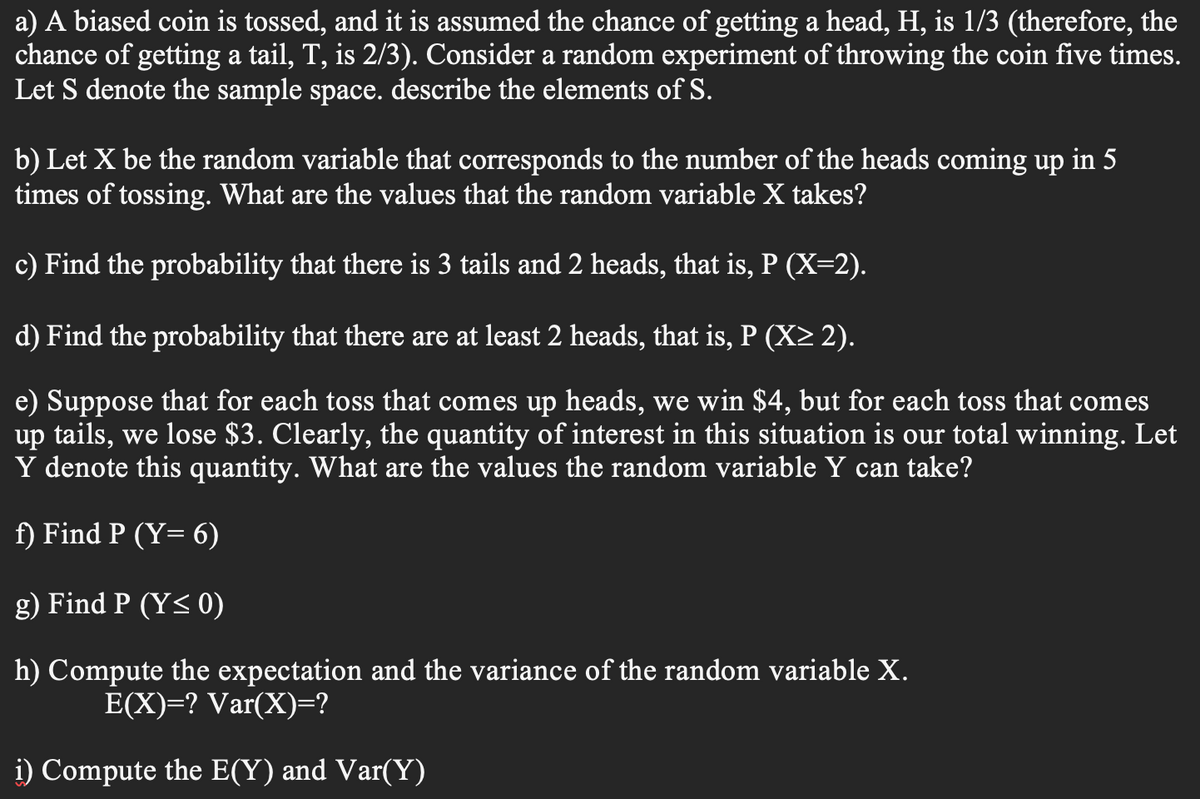a) A biased coin is tossed, and it is assumed the chance of getting a head, H, is 1/3 (therefore, the chance of getting a tail, T, is 2/3). Consider a random experiment of throwing the coin five times. Let S denote the sample space. describe the elements of S. b) Let X be the random variable that corresponds to the number of the heads coming up in 5 times of tossing. What are the values that the random variable X takes? c) Find the probability that there is 3 tails and 2 heads, that is, P (X=2). d) Find the probability that there are at least 2 heads, that is, P (X> 2).
a) A biased coin is tossed, and it is assumed the chance of getting a head, H, is 1/3 (therefore, the chance of getting a tail, T, is 2/3). Consider a random experiment of throwing the coin five times. Let S denote the sample space. describe the elements of S. b) Let X be the random variable that corresponds to the number of the heads coming up in 5 times of tossing. What are the values that the random variable X takes? c) Find the probability that there is 3 tails and 2 heads, that is, P (X=2). d) Find the probability that there are at least 2 heads, that is, P (X> 2).
A First Course in Probability (10th Edition)
10th Edition
ISBN:9780134753119
Author:Sheldon Ross
Publisher:Sheldon Ross
Chapter1: Combinatorial Analysis
Section: Chapter Questions
Problem 1.1P: a. How many different 7-place license plates are possible if the first 2 places are for letters and...
Related questions
Question
step by step please. parts d,e, and f

Transcribed Image Text:a) A biased coin is tossed, and it is assumed the chance of getting a head, H, is 1/3 (therefore, the
chance of getting a tail, T, is 2/3). Consider a random experiment of throwing the coin five times.
Let S denote the sample space. describe the elements of S.
b) Let X be the random variable that corresponds to the number of the heads coming up in 5
times of tossing. What are the values that the random variable X takes?
c) Find the probability that there is 3 tails and 2 heads, that is, P (X=2).
d) Find the probability that there are at least 2 heads, that is, P (X> 2).
e) Suppose that for each toss that comes up heads, we win $4, but for each toss that comes
up tails, we lose $3. Clearly, the quantity of interest in this situation is our total winning. Let
Y denote this quantity. What are the values the random variable Y can take?
f) Find P (Y= 6)
g) Find P (Y< 0)
h) Compute the expectation and the variance of the random variable X.
E(X)=? Var(X)=?
i) Compute the E(Y) and Var(Y)
Expert Solution
This question has been solved!
Explore an expertly crafted, step-by-step solution for a thorough understanding of key concepts.
This is a popular solution!
Trending now
This is a popular solution!
Step by step
Solved in 2 steps with 2 images

Recommended textbooks for you

A First Course in Probability (10th Edition)
Probability
ISBN:
9780134753119
Author:
Sheldon Ross
Publisher:
PEARSON


A First Course in Probability (10th Edition)
Probability
ISBN:
9780134753119
Author:
Sheldon Ross
Publisher:
PEARSON
